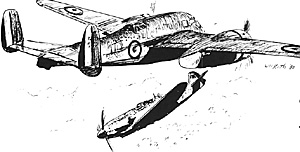 At right, ME-109 vs. Bre.693
At right, ME-109 vs. Bre.693
On the seventeenth of May, Churchill offered to send ten more Hurricane squadrons to France, having misunderstood Dowding's stated minimum requirements for the adequate protection of Britain by RAF Fighter Command. The transfer of these aircraft would seriously strip the homeland's fighter defenses. Fortunately, two days later the Prime Minister reversed his generous and dangerous offer and halted the transfer of fighter planes to France. He also ordered all but three Hurricane squadrons already there to return to Britain. The three units remaining on French soil were to rotate daily with three other squadrons based in England.
Allied tactical air doctrine continued to be sorely inadequate throughout the remainder of the month of May. The lack of reconnaissance and of air support of ground operations did not help the desperate defense being put up by British and French ground forces. On May 19, General Maurice Gamelin, the French commander of the Allied forces on the western front, sent down specific policies regarding French tactical air doctrine. Fighters were (optimistically) ordered to maintain control of the air all along the battle front and to protect the movement of friendly troops and supplies behind the front lines. The remaining (and essentially useless) bombers were instructed to attack advancing enemy units, particularly panzer elements, and to provide muchneeded ground support for the French Second Army. Any spare time the bomber pilots found on their hands was to be spent in attempts to destroy the bridges over the Meuse River by dropping river mines on them.
The extent to which the British air elements participated in the Battle for France is illustrated by the fact that 195 of the total 261 RAF Hurricanes which had been sent to France were destroyed after only ten days of fighting. Only 75 of these were lost in aerial combat, while 120 had been damaged and abandoned at their airfields during the retreat.
On May 22 the RAF evacuated its last continental airbase, at Merville. Three Hurricane squadrons were still being operated from French-run airfields at this time. The historic evacuation of the British Expeditionary Force at Dunkirk from May 29 through June 2 was made possible in large part by fighters of the RAF which provided air cover throughout the embarkation. Without this air protection, ship losses to the Luftwaffe easily could have changed Dunkirk from a miracle into a catastrophe.
More French Air Force in World War II
-
Introduction
Preparation for War
The Machines
The First Week
The Beginning of the End
To The Armistice, 1941-1945
Back to Grenadier Number 12 Table of Contents
Back to Grenadier List of Issues
Back to MagWeb Master Magazine List
© Copyright 1981 by Pacific Rim Publishing
This article appears in MagWeb (Magazine Web) on the Internet World Wide Web. Other military history articles and gaming articles are available at http://www.magweb.com